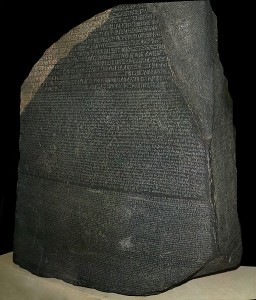To add to our ongoing dialogue regarding text, this image of the Rosetta Stone is representative to me of the meaning of text as we have been defining it over the past two weeks, and it also puts into context the power of written symbol systems. Ultimately, text is nothing without the ability to interpret and make meaning from it.
The Rosetta Stone was the key in humanity’s ability to decode and interpret ancient Egyptian forms of writing. The three forms of writing on the stone from top to bottom are ancient Egyptian hieroglyphs, Egyptian Demotic script and ancient Greek. Scholars used their existing understanding of the ancient Greek language in the early 1800s to decode the two forms of Egyptian writing that appear, enabling a wider capacity to engage in the text systems used by ancient Egyptians, and in turn, our ability to learn more about ancient Egyptian society. More detailed information about the Rosetta Stone from the British Museum, where it is currently situated is available here.
The importance of the actual text, available here in English is almost irrelevant in comparison to the value this artifact had in unlocking the ability of scholars to understand wider ancient Egyptian society. Not only does the Rosetta Stone represent how valuable written symbol systems can be, but also how having the ability to decode the various language systems used by societies is a fundamental part of engaging with them and their ideas, whether it be an ancient or modern society.



